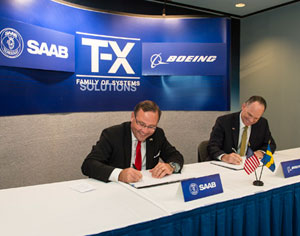
The trainer solution from Boeing and Saab with other potential team members will be a completely new designed aircraft
The US Boeing Company and Saab AB of Sweden announced today they have signed a Joint Development Agreement (JDA) to jointly develop and build a new advanced, cost-efficient T-X Family of Systems training solution for the upcoming competition to replace the U.S. Air Force’s aging T-38 aircrew training system. Boeing will be the prime contractor for the US government bid and Saab AB the primary partner. The trainer solution from Boeing and Saab with other potential team members will be a completely new designed aircraft, built to meet the needs of the Air Force. The agreement covers areas including design, development, production, support, sales and marketing.
![Boeing [NYSE: BA] and Saab AB [Stockholm: SAABB] have signed a Joint Development Agreement (JDA) to jointly develop and build a new advanced, cost-efficient T-X Family of Systems training solution for the upcoming competition to replace the U.S. Air Force’s aging T-38 aircrew training system. Saab President and CEO Håkan Buskhe, left, and Boeing Military Aircraft President Chris Chadwick sign the Joint Development Agreement document. Photo: Boeing](http://defense-update.com/wp-content/uploads/2013/12/saab_boeing.jpg)
“We are sure this is the best way to supply affordable first-class trainers to the U.S. Air Force,” said Saab President and CEO Håkan Buskhe. “We will invest in development of this completely new aircraft design over the coming years. This cooperation with Boeing is part of our strategic development and we confirm our long-term financial targets.”
[nonmember]To read more about the T-X competition and how Boeing/Saab team blends in, please SUBSCRIBE or sign-in (on the top of the sidebar to the right).[/nonmember][ismember]Both companies are offering advanced fighter aircraft such as the F/A-18, F-15E and Gripen NG, but both are dependent on competitors such as BAE Systems, Alenia Aermacchi or Lockheed Martin to provide an advanced trainer solution. With fighter jet programs becoming increasingly expensive and risky, they are often committing offerors to complete life cycle costs that includes pilot training, and pilot skill proficiency trainers (simulators), each part therefore contributes to the overall program profitability. Shedding the training and simulation part to other systems manufacturers would, therefore erode potential revenues of otherwise profitable program.
The U.S. Air Force T-X program will include aircraft and training that will prepare warfighters for the next 40 years. The Air Force plans to replace the T-38 with a new Advanced Pilot Training Family of Systems and about 350 aircraft, plus associated ground-based training systems and logistics and sustainment support.
New trainers are required to improve the training of jet pilots for the newest fifth generation fighters. Today’s fighter jets present a relatively simple to operate operating environment, but require the pilot to deal with highly dynamic and complex information environment, performing increasingly complex missions. Therefore, new trainers should present pilots with advanced capabilities, particularly in information management and sensors operation, reflecting 4.5 and fifth generation jet fighters like the F-22 Raptor and the F-35 Lightning II.
The training systems based on aircraft and simulators will have to fulfill different basic training roles including basic aircraft control, airmanship, formation, instrument and navigation skills, as well as more advanced skills like air-to-air and air-to-ground combat as well as advanced resource management. The new trainer should also prepare new pilots to deal with sustained operation under high loads, experiencing high-G maneuvering, practicing aerial refueling, operating at night with night vision imaging systems and more.
Although the formal request for proposals has not been released yet, several competitors are expected to submit existing aircraft while others are considering all new designs. The Air Force has said it prefers to buy an off the shelf solution with as little development cost as possible. Given the large scale of the program, all offerors are likely to be US primes, alas, the absence of a suitable US origin platform would require each U.S. prime to join with a foreign aircraft builder manufacturer providing a proven platform design. Companies expected to bid include Northrop Grumman, teamed with BAE Systems to offer the Hawk, Lockheed martin, teamed with Korean Aerospace Industries (KAI), to offer the T-50 Golden Eagle and Alenia Aermacchi offering the M-346 Master, under a teaming agreement with General Dynamics C4. Boeing had an existing partnership with Alenia to market the M-346 internationally, but for the US contract preferred instead to partner with Saab for the development of a brand new trainer. Teaming with Saab would offset some of the development costs.[/ismember]
















